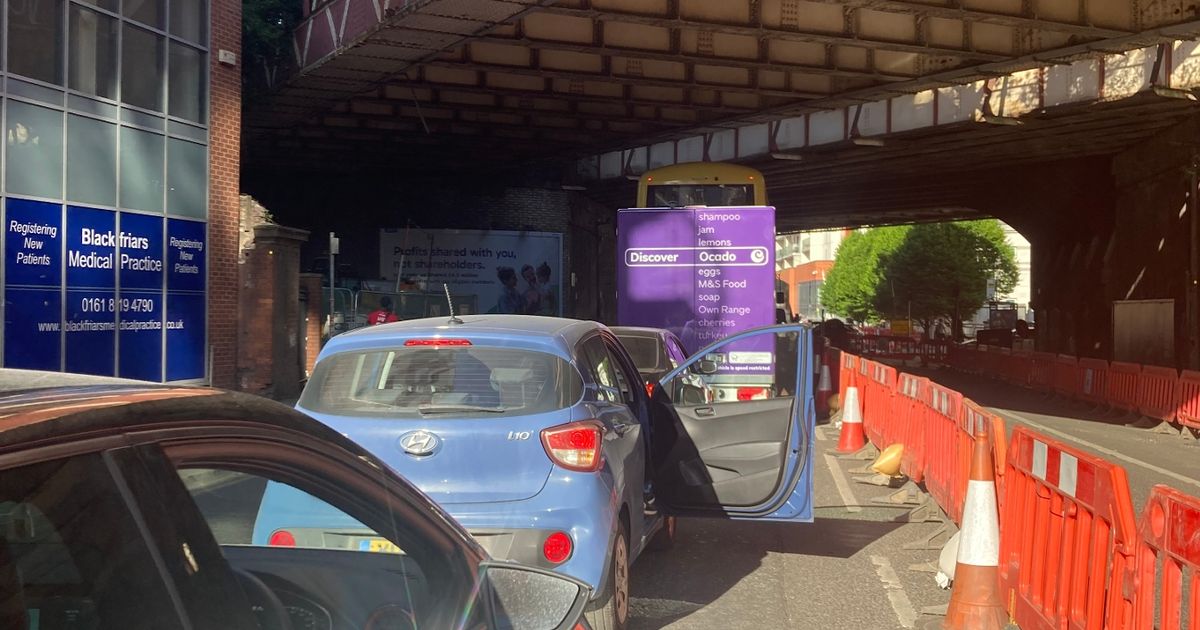One woman said her commute from Bolton to Manchester took FOUR HOURS during ongoing roadworks
18:59, 14 May 2025Updated 19:14, 14 May 2025
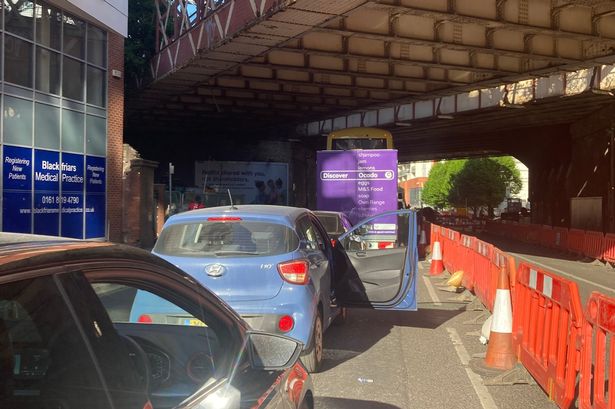 Congestion on Chapel Street (Image: Manchester Evening News)
Congestion on Chapel Street (Image: Manchester Evening News)
The first thing that strikes you is the silence.
It’s rush hour on Salford’s Chapel Street and the cars are bumper to bumper – but it is eerily quiet.
No grinding of brakes or humming of exhausts – instead, cars are parked up, engines off, keys out of the ignition and doors thrown open. Many drivers have been stuck where they are for over an hour.
This stretch of road between New Bailey Street and Blackfriars Street has been closed westbound since last Monday (May 5) as Salford council contractors begin work to install cycle lanes and increase space for pedestrians and buses – work that will take a year to complete.
But buses were stuck in the queue as well – with one stuck awkwardly on the box junction at Bridge Street, engine off, driver standing around, door wide open and passengers staring out the window agog.
Local residents from the blocks of flats lining the street came out to sit on the curb and watch the chaos. One man had even taken matters into his own hands, moving the orange hoardings marking the closure so that some drivers could turn right down Spaw Street and escape.
There was a four-way lights system in place at the Blackfriars crossroads, meaning that traffic coming from three directions – Victoria, St Mary’s Gate and eastbound from Bridge Street – only had one way to go, northbound up Blackfriars Road for a merciful escape onto Trinity Way.
Salford council have said that the closure ‘represents the best solution currently available to deliver the works safely and efficiently’. But the result so far has been utter gridlock that has seen as many as 40 buses queuing along the street and daily commutes turned from 20 minutes to two hours or more.
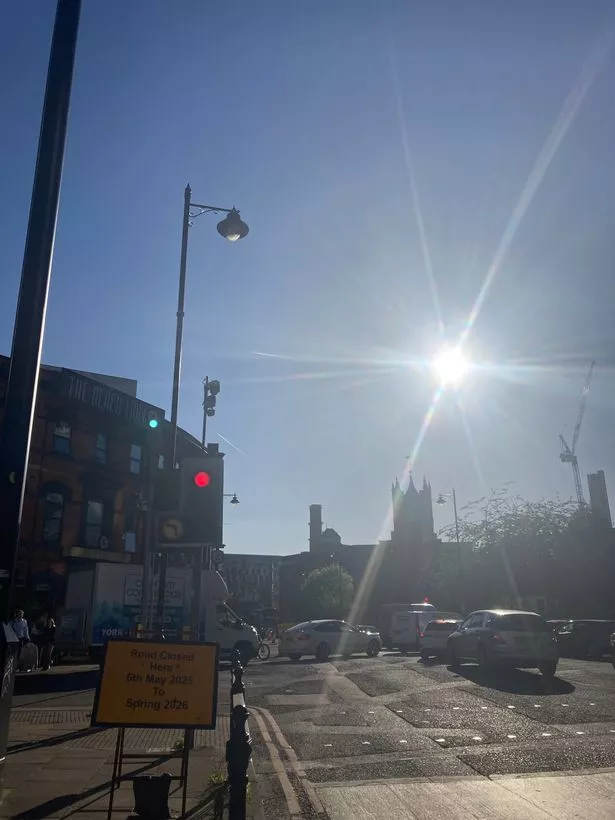 Gridlock at the junction on Blackfriars Street(Image: Manchester Evening News)
Gridlock at the junction on Blackfriars Street(Image: Manchester Evening News)
24-year-old Alex was one such example. On Tuesday (May 13) she had been stuck for the best part of an hour when she spoke to the Manchester Evening News and was sat in her car with the engine off, on the phone with her boyfriend.
“It’s crazy,” she said. “I can literally see my block of flats from here but I can’t get to it.”
“On Thursday it took me four hours to get home from Bolton – it normally takes me 25 minutes. Just to get from Trinity Way to Blackfriars Road took me two hours.”
“My boyfriend actually had to come down and swap with me and sit in the car so I could go home and go to the toilet. Then he was sat here for another hour or so just to travel about 500 yards.”
Alex said she had heard that the traffic had been worsened by an issue with the temporary lights on Blackfriars Street. “They aren’t on long enough,” she said. “Cars couldn’t get through and were getting stuck on the box junction, which just backed it up even more.”
She drives to Bolton a few times a week for work. “I drive because petrol is cheaper, and it’s cheaper at point of use,” she said. “I’m already paying for a car so public transport would be another expense on top. And rail connections to Bolton aren’t great either.
Ahead of her in the queue, Alex recognised a neighbour from her flat. 27-year-old Megan was also sat stationary with her door open, using the enforced downtime to catch up on work.
It wasn’t the first time she’d fallen foul of the roadworks. “In the mornings it takes me about 40 minutes to get out of Dearmans Place, just to turn right,” she said. “And then another twenty or thirty minutes just to get to Blackfriars – which normally takes me two minutes.”
“I have to travel for work, it takes me all over: Bolton, Preston, Burnley. I have to drive but at this rate I won’t be able to.”
On Tuesday she was heading home from Bolton. “It’s normally about a 20 minute journey but so far it’s taken me two hours. I didn’t hit any traffic until the junction with Trinity Way.
“If there was some sort of emergency or crash, how are police or ambulances meant to get through here? It’s never been as bad as it is today.
“Now they’ve shut Deansgate so it’s one way, there’s only really Quay Street and the Mancunian Way left. It’s going to grind to a halt. There’s already a bike lane and footpaths on both sides so I don’t see why it needs to be pedestrianised.”
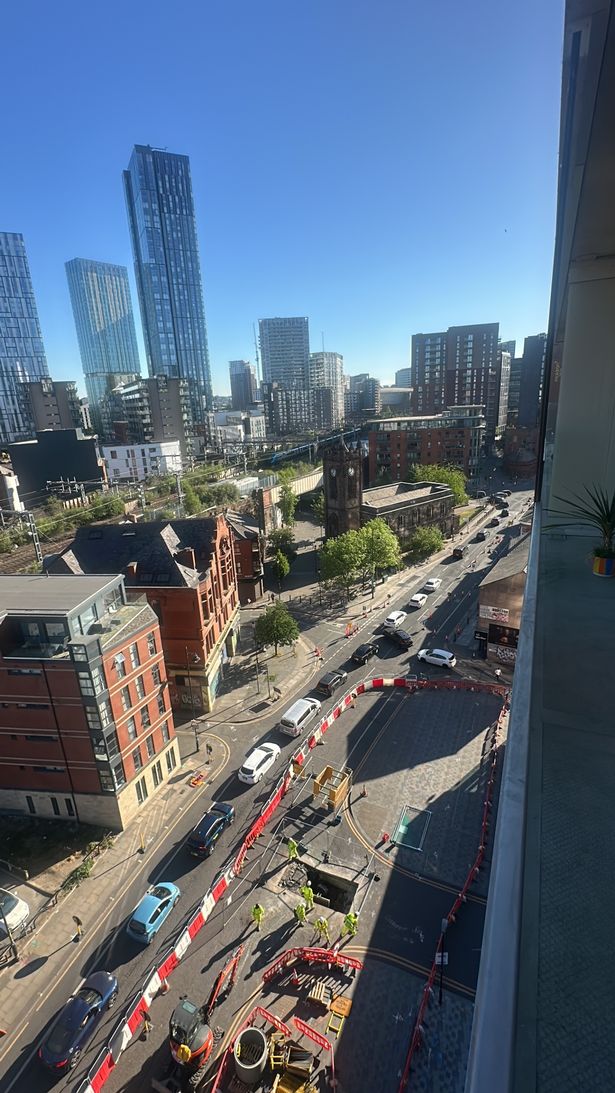 The view from above(Image: UGC)
The view from above(Image: UGC)
As well as office commuters, the queue was dotted with motorists in vans and trucks who had no choice but to make the journey on four wheels. 29-year-old James was at the wheel of an Ocado delivery van and said he had been stuck for nearly an hour and a half.
“I have a delivery to make just around the corner – I’ve been in town all afternoon and I’ve got two stops left, but I have just driven into this sh**show,” he said ruefully.
“My boss is understanding of the situation, and I’ve explained that there’s not a lot I can do. I’ve just got to see where I’m at once all this clears.”
“But I’m a bit gutted I’m stuck here – and it will mean some deliveries won’t make it.”
35-year-old Nick was also in stuck in his work van. Employed by a carpet cleaning company, he said he was comparatively ‘lucky’ to have finished for the day and was heading back to his car.
“I’ve been here for nearly two hours,” he told the M.E.N. “I can’t believe how bad it is. It’s taken me two hours to drive 200 yards from Affinity Living on Bridge Street.”
“I’ve actually ended up sending the M.E.N article to my boss to let him know for next time so we can change the times we go out on jobs. But if it had clashed with work, it would have been a nightmare. I’m glad I’ve let him know.”
Another driver on his way home was Bill Urbano. The 36-year-old works in scaffolding and said he had been stuck on Chapel Street since about 4:30pm.
“There’s nothing organising it at all,” he said of the road closures. “It’s a bit of a free for all. It needs better organisation. But yesterday I left at the same time and it wasn’t that bad – so I don’t know what’s gone on.”
“I drive around town a lot for work and it normally takes me about 25 minutes to get home to Failsworth. I couldn’t do this job without driving – if you don’t have your tools what are you supposed to do?”
Bill said he worked for someone else rather than running his own business so couldn’t say if he’d be affected financially. “But it’s affecting my time. I’m not getting paid for sitting in traffic for two hours.”
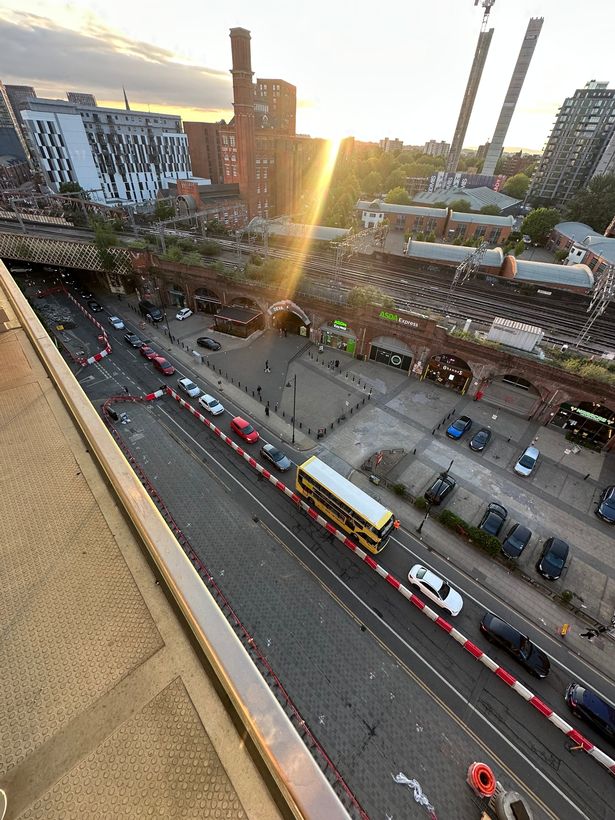 The view from above (Image: UGC )
The view from above (Image: UGC )
Closest to freedom at the junction with Blackfriars Street was Justin Marks. The 54-year-old had been stuck in the queue for 55 minutes.
“I’ve already raised it with Salford Council,” he said as the M.E.N approached. “I’ve put in two complaints already – and I’m going to make another one tonight.”
“It’s just crazy. My office is on Dearmans Place and we used to come out by the Lowry and turn left to get to Trinity Way. Now we have to go all the way around.
“It hasn’t been managed properly at all. All the exit routes off Chapel Street have been closed off and New Bailey Street is one way as well.
“We’re based in Salford and we want to stay in Salford – but I’m genuinely convinced [the council] are making it as difficult as they possibly can to drive in Manchester. We rent parking space in Salford but this might mean moving our business away.
“I live in Lymm so there’s little public transport where I live. My options are to drive, or take my business out of Manchester altogether.”
What Salford council say
Councillor Mike McCusker, Lead Member for Planning, Transport and Sustainable Development at Salford City Council said:
“Salford City Council have planned the works on Chapel Street carefully, and as part of that process all partners have considered and explored a number of options to maintain traffic flows in the city centre. This was in partnership with Manchester City Council and Transport for Greater Manchester.
“The current one-way closure remains the safest, most efficient option to complete the works, balancing the needs of residents, businesses, pedestrians, cyclists, and public transport in a constrained city centre environment.
“The one-way closure extends over approximately 400 meters of the city centre road network. While roadworks can impact disruption to traffic flow, the periods of increased congestion and delays are primarily due to the overall capacity of the network being affected by a combination of incidents, popular events, and high vehicle volumes, rather than solely by the temporary roadworks.”
